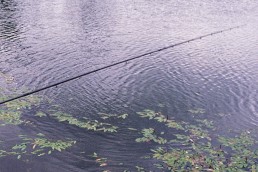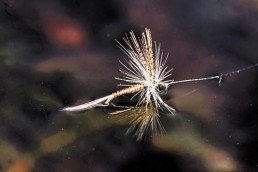Everywhere-a-Dap Dap
SHARE THIS POST
It’s time for several things to happen to the technique of “dap fishing” or “dapping.” The first thing to do is to bring it across the ocean from England and to our banks, literally. Secondly, it needs to be wrest away from the all high and mighty hands of fly fishermen. Just because fly fishing uses flies, doesn’t make it the exclusive domain of our wet-legged brethren. And third, it should be demystified from highly specialized techniques to ones that everyone can put into his/her arsenal for catching fish.
The British Isles usually take credit for inventing fly fishing, but I’m guessing that it was at least co-invented here in the Americas. Dapping is probably one of the first methods invented for catching fish with a pole and line. My hypothesis is that dapping was one of the first forms of line-and-pole fishing. Noodling was probably the first method for catching fish, with spearing a close second. Being very observant, these ancient people certainly noticed insects flitting just over and on the surface of water and saw fish rising to slurp them down. Some rocket scientist of the day figured out that if he/she attached a “line”— let’s say, made of thinly stretched animal gut—to a long branch or stem most likely made of a willow or cane, and tied a small feather to the end of the line, it would imitate those dancing insects.
Let’s tackle the first and third items together. Dapping uses flies, but there is no casting involved. It is also an effective technique to fish for species other than trout, so you don’t have to drive hundreds of miles to trout streams to practice it. River or lake, boat, shore, or wet-to-your-waist, it is an effective method, especially in places where fly-casting could never put a fly. I said earlier that many people have dismissed dapping in the past, because dapping is pretty much using a cane pole and fishing with a short line. In a nutshell, it is dangling a fly on or just above the surface, imitating one of the many aquatic insects that breed by laying their eggs on the surface of water—mayflies and damselflies are two examples.
The equipment you need is simple. A l0- to 13-foot fly rod or crappie rod is good, but a 14- to 18-foot extension pole also works well. If you are going after big fish that might make long runs, a fly rod with 10 feet of backing would work. Most of my dapping is with a 12- to 16-foot extension pole, and the flex of these long poles is enough to easily fight and land a three- to four-pound fish. The only caveat with long poles is their weight. The pole should be light enough to control with one hand. There is special line called dapping floss that can be used, or I like any of the super lines since they are very thin compared to the breaking strength. You will need to experiment with the length of line, but a short 6- to 8-foot length is long enough not to spook the fish with the pole and short enough to control what the fly is doing.
The basic idea is to let your fly dance on the top or just above the water, letting as little of the line touch as possible. Take some time to watch mayflies, damselflies and dragonflies when the female is depositing eggs on the surface. They generally flit within inches of the surface either dropping their eggs or dipping their abdomen into the water. Sometimes the male (damsel) will still be attached near the head of the female. Female mayflies tend to sit on the surface when depositing eggs. This is the behavior that dapping is intended to imitate.
Are you enjoying this post?
You can be among the first to get the latest info on where to go, what to use and how to use it!
Dapping floss is using a flat line that looks much like overly large dental floss. The idea behind this floss is that it will more easily catch the wind and give a more natural flitting action. I have tried it and understand the idea but have not had much success with it. You might have to research a European supplier such as SportFish (a UK supplier) or Amazon.uk for a good selection of dapping floss.
The traditional dry flies to use for dapping are the same ones used for trout: the Royal Coachman, the Adams, the Quills and the Duns. Remember that this technique can and should be used for panfish, bass and any other fish that can be found in shallow areas, so any dry fly imitation will work.
Terrestrial insects mistakenly land or fall in water and become tasty prey for fish. So using ant and grasshopper imitators (they’re easy to tie) will work well between the various hatches. The natural colors are grays, tans and browns, but I have had lots of success with yellows and reds with white wings. I like these colors since they are more visible to my aging eyes. A big advantage of dapping over fly casting, especially for the non fly fisher, is that you can use size 16, 18 and even 20s on 1- or 2-pound line with little trouble and to great effect. Another advantage is that you can place flies in spots that would be totally inaccessible by casting, like heavily brushed shorelines or reed beds.
Some stealth is required since you are very close to the fish. Muted clothing and a low profile keep fish from easily spotting you. Slow, quiet movements, either from boat, shore or wading, also help. Good polarized sunglasses help since dapping works best when sight-fishing. This is not a run-and-gun technique like baitcasting, and is a truly (dare I say use this overused word?) finesse technique.
My dad taught me dapping with a cane pole as my first fishing technique, even though he didn’t know it at the time. He was probably tired of removing hooks from various body parts as a result of wayward casts and instead showed me how to dangle a worm right above a fish. The fly fishers have tried to keep dapping their secret (as they do with so many good fishing techniques), but it is time for it to go mainstream (pun intended). It is not for every fishing situation or species of fish, but you already have most of the equipment. All you have to do is a little adaptation, and with a short learning curve, you will be catching dapped fish.
MWO
SHARE THIS POST
Did you enjoy this post?
You can be among the first to get the latest info on where to go, what to use and how to use it!
Doug Thalacker
Doug Thalacker has a Masters of Environment Science from UW-SP and taught high school environmental science and earth science. He has outdoor/wilderness training through Outward Bound and American Red Cross. He has a lifetime of enjoying any activity that involves fields, woods or waters.



